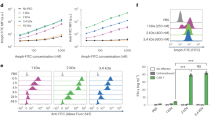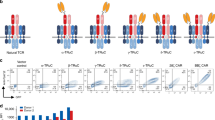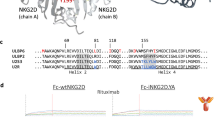Abstract
Chimeric T cell receptors with specificity for tumor-associated antigens are successfully used to target T cells to tumor cells. The efficacy of this approach, however, is reduced by soluble antigen that is frequently present in high serum concentrations. To overcome this situation, we constructed an anti-CEA chimeric receptor whose extracellular moiety is composed of a humanized single chain antibody fragment (scFv) derived from the anti-CEA mAb BW431/26 and the CH2/CH3 constant domains of human IgG. The intracellular moiety consists of the γ-signaling chain of the human FcεRI receptor constituting a com- pletely humanized chimeric receptor. After transfection, the humBW431/26 scFv-CH2CH3-γ receptor is expressed as a homodimer on the surface of MD45 T cells. Co-incubation with CEA+ tumor cells specifically activates grafted MD45 T cells indicated by IL-2 secretion and cytolytic activity against CEA+ tumor cells. Notably, the efficacy of receptor-mediated activation is not affected by soluble CEA up to 25 μg/ml demonstrating the usefulness of this chimeric receptor for specific cellular activation by membrane-bound CEA even in the presence of high concentrations of CEA, as found in patients during progression of the disease.
This is a preview of subscription content, access via your institution
Access options
Subscribe to this journal
Receive 12 print issues and online access
$259.00 per year
only $21.58 per issue
Buy this article
- Purchase on Springer Link
- Instant access to full article PDF
Prices may be subject to local taxes which are calculated during checkout





Similar content being viewed by others

References
Gross G, Eshhar Z . Endowing T cells with antibody specificity using chimeric T cell receptors FASEB J 1992 6: 3370–3378
Eshhar Z, Waks T, Gross G, Schindler DG . Specific activation and targeting of cytotoxic lymphocytes through chimeric single chains consisting of antibody-binding domains and the γ or ζ subunits of the immunoglobulin and T cell receptors Proc Natl Acad Sci USA 1993 90: 720–724
Hwu P et al. Lysis of ovarian cancer cells by human lymphocytes redirected with a chimeric gene composed of an antibody variable region and the Fc receptor gamma chain J Exp Med 1993 178: 361–366
Moritz D, Wels W, Mattern J, Groner B . Cytotoxic T lymphocytes with a grafted recognition specificity for ERBB2-expressing tumor cells Proc Natl Acad Sci USA 1994 91: 4318–4322
Hwu P et al. In vivo activity of T cells redirected with chimeric antibody/T cell receptor genes Cancer Res 1995 55: 3369–3373
Eshhar Z et al. The T-body approach: potential for cancer immunotherapy Semin Immunopathol 1996 18: 199–209
Abken H, Hombach A, Reinhold U, Ferrone S . Can combined T cell and antibody-based immunotherapy outsmart tumor cells? Immunol Today 1998 19: 2–5
Gross G et al. Chimeric T cell receptors specific to a B-lymphoma idiotype: a model for tumor immunotherapy Biochem Soc Transact 1995 23: 1079–1083
Fletcher RH . Carcinoembryonic antigen Ann Intern Med 1986 104: 66–73
Bosslet K et al. Immunohistochemical localization and molecular characteristics of three monoclonal antibody-defined epitopes detectable on carcinoembryonic antigen (CEA) Int J Cancer 1985 36: 75–84
Murakami M et al. Binding reactivity of monoclonal anti-carcinoembryonic antigen (CEA) antibodies with cell membrane-bound CEA and with free CEA in solution Immunol Invest 1996 25: 23–35
Kaulen H et al. Humanized anti-carcinoembryonic antigen antibody: strategies to enhance human tumor cell killing Year Immunol 1993 7: 106–109
Bruynk A, Seemann G, Bosslet K . Charcterization of a humanized bispecific monoclonal antibody for cancer therapy Br J Cancer 1993 67: 436–440
Shu L, Qi SF, Schlom J, Kashmiri SVS . Secretion of a single-gene encoded immunoglobulin from myeloma cells Proc Natl Acad Sci USA 1993 90: 7995–7999
Pohl C et al. CD30-specific AB1-AB2-AB3 internal image antibody network: potential use as anti-idiotype vaccine against Hodgkin’s lymphoma Int J Cancer 1993 54: 418–425
Blomberg K, Ulfstedt AC . Fluorescent europium chelates as target cell markers in the assessment of natural killer cell cytotoxicity J Immunol Meth 1993 160: 27–34
Moertel CG et al. The pre-operative carcinoembryonic antigen test in the diagnosis, staging, and prognosis of colorectal cancer Cancer 1986 58: 603–610
Author information
Authors and Affiliations
Rights and permissions
About this article
Cite this article
Hombach, A., Koch, D., Sircar, R. et al. A chimeric receptor that selectively targets membrane-bound carcinoembryonic antigen (mCEA) in the presence of soluble CEA. Gene Ther 6, 300–304 (1999). https://doi.org/10.1038/sj.gt.3300813
Received:
Accepted:
Published:
Issue Date:
DOI: https://doi.org/10.1038/sj.gt.3300813
Keywords
This article is cited by
-
Strategies to genetically engineer T cells for cancer immunotherapy
Cancer Immunology, Immunotherapy (2016)
-
Regression of established renal cell carcinoma in nude mice using lentivirus-transduced human T cells expressing a human anti-CAIX chimeric antigen receptor
Molecular Therapy - Oncolytics (2014)
-
T cells redirected by a CD3ζ chimeric antigen receptor can establish self-antigen-specific tumour protection in the long term
Gene Therapy (2013)
-
Effector memory and central memory NY-ESO-1-specific re-directed T cells for treatment of multiple myeloma
Gene Therapy (2013)
-
Transfer of mRNA encoding recombinant immunoreceptors reprograms CD4+ and CD8+ T cells for use in the adoptive immunotherapy of cancer
Gene Therapy (2009)


